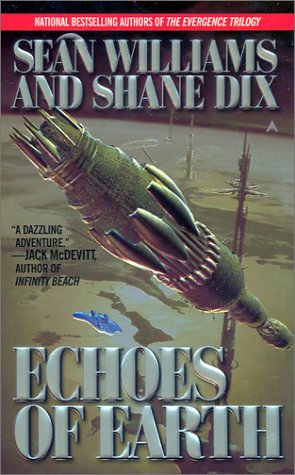Echoes of Earth
by Sean Williams and Shane Dix

Published by Penguin Putnam

Michael's Rating: 4 out of 4

In the early 22nd century, humans have shed their bodies to travel through space. Produced through nanotechnology, their electronic reproductions, known as engrams, have been sent on fact-finding missions throughout the known universe - searching for signs of alien life...
As the engram crew of a survey ship watches, ten orbital towers are constructed around an uninhabited planet's equator - by unidentifiable, spindle-shaped entities. Then, without any attempt at communication, the spindles withdraw. Cautiously exploring the towers, Peter Alander finds what appear to be gifts from a technologically-advanced race, including a faster-than-light ship. But when Alander pilots the ship back to Earth with news of the unprecedented event, he may be giving humanity a gift it can't afford to accept...
"Echoes of Earth" is a grand adventure in the traditional style of Williams & Dix, with a scope that engulfs a broad canvas of galactic events, whilst focusing on the journey of discovery of the individual, namely the central character - Peter Alander.
Peter Alander, and the rest of the crew of the 'Frank Tipler' are Engrams - nanotech copies of their originals. Peter Alander, as an Engram, reminded me of the character Data from "Star Trek: The Next Generation". Like Data, Peter Alander is always striving to reach a potential further than his original programming. Another comparison could be made to David, the central character from the movie AI. An occurring theme resonating throughout the novel is the eternal question often asked - "Who am I?" - is Peter Alander limited to think, behave and act like his original, or does he have the potential to grow and become an individual in his own right. Further compounding Peter's dilemma is the revelation later in the novel that many of the Engrams based on the Peter Alander template have had mental breakdowns. This personal quest drives the storyline, and sets significant and powerful events into motion.
The status of humanity in the novel reminds me of the Matrix, whereby majority of individuals have been absorbed into various AI's. Events unfold within the book that suggest it could be potentially loosely tied to the 'Evergence' trilogy, as the remnants of humanity could be a precursor to the Crescend.
As with all Williams & Dix collaborations, the novel is chock full of goodies, including numerous appendixes and a timeline. One of the notable usages of future terminology, is the use of the Planck System of measurement.
Sean Williams incorporates many of his personal favourite subjects of debate into the novel, including immortality, privacy and virtual reality. Sean Williams has incorporated many themes from the Australian television series featured on the ABC, called 'Aftershock' - in which Sean was a panel member. One of these themes, is the theory of the 'Spike', which originated from Damien Broderick's book of the same name. He was also a panel member of the same television show as Sean.
I am really looking forward to the sequels of this novel, which are titled: "Orphans of Earth" (2003) and "Heirs of Earth" (2004). A one year wait between novels is simply too long to bear!

